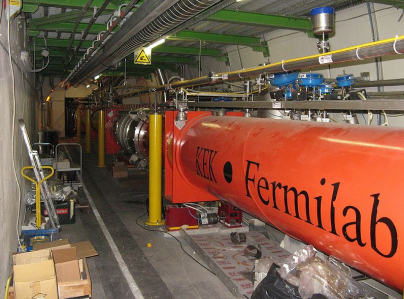By Jason Ho (Science Whiz) – Email
Print Edition: July 8, 2011
 One hundred meters below the border between France and Switzerland lies perhaps one of the largest science projects taking place in the world today – the Large Hadron Collider (LHC). The LHC is the world’s largest particle collider, spanning a 27 kilometre circumference, and is run by the European Organization for Nuclear Research (also known as CERN). The LHC is capable of producing particle collisions at 99.9999991 per cent the speed of light. Over 150 universities are represented in the project, with thousands of scientists from all over the world participating. And for what reason? To search for a single particle, the elusive Higgs boson.
One hundred meters below the border between France and Switzerland lies perhaps one of the largest science projects taking place in the world today – the Large Hadron Collider (LHC). The LHC is the world’s largest particle collider, spanning a 27 kilometre circumference, and is run by the European Organization for Nuclear Research (also known as CERN). The LHC is capable of producing particle collisions at 99.9999991 per cent the speed of light. Over 150 universities are represented in the project, with thousands of scientists from all over the world participating. And for what reason? To search for a single particle, the elusive Higgs boson.
Actually, several experiments in particle physics are currently being done at the LHC, but the one perhaps most often spoken about is the search for the Higgs boson. Finding the Higgs boson is important to scientists because if it exists, it will complete the theory known as the Standard Model of particle physics. The Standard Model provides a description of how all known particles interact with one another, and how all but one of the fundamental forces in our universe are generated; it describes the electromagnetic force, and what are called the strong and weak nuclear forces (forces which govern properties of atomic nuclei). Essentially, it explains most everything except gravity, so by completing the Standard Model, scientists will have come much closer to finding a theory of “everything” – that is, one theory that can describe all physical phenomena, which is one of the biggest problems in physics right now.
The reason the Higgs boson is necessary to complete the Standard Theory is that it is needed to describe why and how all of the other particles have mass. The Standard Model as we know it now does not describe why some particles have mass, and why some don’t (for example, electrons and quarks – the building blocks for most observed matter – have mass, and photons – which make up visible light – do not). The Higgs boson is a component of a theorized mechanism which would explain how and why different particles have such different masses.
Those who are more pragmatic might ask how this endeavour is relevant to humanity in general. While there may not be obvious, direct applications of the breakthroughs at the LHC to the everyman, whenever questions arise as to the practicality of scientific study, it is valuable to look into history for the answer. General Relativity, Einstein’s theory of gravity as geometry, has led to many technologies being developed, with the most well-known being the Global Positioning System. Research into black holes by John O’Sullivan in 1977 led to the development of wireless internet. Around 15 million gigabytes of data are generated by the LHC every year, and are stored in computing grids networked across the globe on the LHC Computering Grid – linking computers in 35 different countries together for the purposes of storing and analyzing all of the data produced. While there may not be an immediate, practical application of the discoveries at the LHC, technological developments along the way may prove to be invaluable to the general public.
It is possible that the Higgs may not exist at all. if that is the case, it would be a sign that the Standard Model is incomplete and other explanations might need to be pursued. Only time will tell what will be found. One thing is certain; the experiments being performed at the Large Hadron Collider will greatly further our knowledge of the nature of matter and the universe around us.


